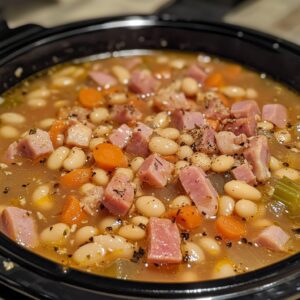
Hearty Ham and Bean Soup Recipe: A Soul-Warming Classic
There’s something deeply comforting about a bowl of Hearty Ham and Bean Soup. It’s the kind of recipe that fills your home with irresistible aromas and promises of warmth and nourishment. Whether you’re making use of leftover ham or preparing fresh ingredients, this soup is a delightful, hearty meal for any time of the year. The combination of savory ham, tender beans, and fresh vegetables creates a harmony of flavors that will have you coming back for seconds (or thirds!). With this recipe, you can embrace the simple joys of homemade cooking while adding your own personal touch.
Ingredients Overview
1. Ham (1 lb, diced):
The ham is the soul of this soup. The choice of ham can drastically affect the flavor of the soup, so choose wisely. If you’re using leftover ham, it will have a richer, smokier taste, which will infuse into the broth and beans. For a fresher flavor, go with a lean ham steak or diced ham. You can even experiment with a smoked ham hock for an even deeper flavor.
Tip: To make the soup even more flavorful, use a bone-in ham. The bone will release even more flavor into the broth as it simmers.
2. Onion (1, chopped):
Onions are the base of many soups, offering sweetness and depth. You can choose between yellow, white, or red onions. Yellow onions tend to have the most balanced flavor, making them the perfect choice for this soup.
Tip: For a richer onion flavor, caramelize the onions in the olive oil before adding the other vegetables. This brings out their natural sweetness.
3. Carrots (3, sliced):
Carrots add color, sweetness, and a subtle crunch. They also offer a boost of vitamin A, making this soup as healthy as it is comforting.
Secret: If you prefer a smoother texture, you can puree half of the carrots once the soup is done cooking for a creamier finish.
4. Celery (3 stalks, chopped):
Celery adds a crunchy texture and a fresh, earthy flavor to the soup. It’s essential for achieving that perfect balance of flavors in the broth.
Tip: Don’t discard the celery leaves—they have a ton of flavor and can be finely chopped and sprinkled on top of the soup as a garnish.
5. Garlic (3 cloves, minced):
Garlic adds a punch of flavor, complementing the richness of the ham and the earthiness of the beans.
Secret: Sauté the garlic until fragrant before adding it to the pot. This will unlock the natural oils and intensify the garlic flavor.
6. Great Northern Beans (2 cans, 15 oz each, drained and rinsed):
These beans are the heart of the soup, soft and creamy, absorbing all the savory flavors from the broth. You can substitute with other white beans, such as cannellini or navy beans, if desired.
Tip: For extra flavor, try using dried beans. Just soak them overnight and add them to the soup—this will give the soup an even more homemade, hearty flavor.
7. Bay Leaf (1):
Bay leaves are essential in many soups and stews. Their subtle bitterness balances the sweetness of the vegetables and enhances the depth of the broth.
Tip: Always remember to remove the bay leaf before serving. It’s not edible and can be quite tough if left in.
8. Dried Thyme (1 tsp):
Thyme is a versatile herb that brings a warm, slightly minty, and earthy flavor to the soup. It’s a classic pairing with beans and ham.
Secret: If you have fresh thyme on hand, use it instead of dried thyme for an even more aromatic flavor. 1 tablespoon of fresh thyme is equivalent to 1 teaspoon dried.
9. Dried Parsley (1 tsp):
Parsley adds a fresh, green element to balance out the richness of the ham and beans.
Tip: Use fresh parsley at the end for garnish, and save the dried parsley for cooking.
10. Chicken or Vegetable Broth (6 cups):
The broth is the foundation of this soup, infusing it with flavor. Use low-sodium broth to control the salt levels in the soup.
Tip: Homemade broth will make a significant difference in the taste, as it has a fresher, more complex flavor than store-bought versions.
Step-by-Step Cooking Instructions
1. Prepare the Ingredients
Prepping your ingredients before cooking not only saves time but ensures a smooth cooking process. Dice the ham, chop the vegetables, and mince the garlic. It helps keep the cooking flow organized, especially when you’re sautéing multiple ingredients.
Tip: Use a sharp knife to chop your vegetables. A sharper blade will make the prep work easier and more precise.
2. Sauté the Vegetables
In a large pot, heat 1 tablespoon of olive oil over medium heat. Add the chopped onions, carrots, celery, and minced garlic. Sauté for 5-7 minutes until softened and fragrant. This is when your kitchen will start to smell heavenly!
Tip: Don’t overcrowd the pan. If necessary, sauté the vegetables in batches to ensure they cook evenly.
Secret: For an even deeper flavor, you can add a splash of white wine after sautéing the vegetables. Let it reduce to cook off the alcohol and leave behind a richer base for the soup.
3. Add the Ham
Stir in the diced ham and cook for another 2-3 minutes, letting it brown slightly and soak up the flavors of the vegetables. This step really enhances the savory taste of the ham.
Tip: If you want the ham to crisp up a bit, let it cook undisturbed for 1-2 minutes before stirring.
4. Add the Seasonings
Add dried thyme, dried parsley, and the bay leaf to the pot. Stir well to distribute the seasonings evenly throughout the soup.
Tip: Fresh herbs can be tied together with kitchen twine and added whole to the soup. Remove them easily after cooking for a burst of fresh flavor.
5. Add the Beans and Broth
Pour in the chicken or vegetable broth, followed by the drained and rinsed beans. Stir to combine and bring to a boil over high heat.
Secret: To give the soup an extra savory punch, try adding a couple of splashes of Worcestershire sauce or a dash of soy sauce before bringing it to a boil.
6. Simmer and Serve
Once the soup boils, reduce the heat to low and simmer for 30-40 minutes, stirring occasionally. The soup will thicken, and the flavors will deepen. Remove the bay leaf before serving, and taste the soup to adjust the salt and pepper.
Tip: For a more hearty texture, mash a portion of the beans with a fork or potato masher before serving to thicken the soup.
Frequently Asked Questions (FAQs)
1. Can I use a different type of bean? Absolutely! While great northern beans are traditional, you can also use cannellini or navy beans for a slightly different texture.
2. Can I make this soup with a ham bone? Yes, using a ham bone will add even more flavor to the broth! Simply simmer it in the broth along with the other ingredients and remove it before serving.
3. How can I make this soup vegetarian? To make the soup vegetarian, omit the ham and use vegetable broth as the base. You can add some smoked paprika or liquid smoke to mimic the smoky flavor of the ham.
4. Can I freeze this soup? Yes, this soup freezes wonderfully. Let it cool completely before transferring it to an airtight container or freezer bag. It can be stored in the freezer for up to 3 months.
5. How can I thicken the soup? If you prefer a thicker consistency, you can mash some of the beans with a potato masher or use an immersion blender to puree a portion of the soup.
6. Can I use fresh herbs instead of dried? Yes, fresh herbs can be used in place of dried. For thyme and parsley, use 3-4 sprigs of fresh thyme and 1 tablespoon of fresh chopped parsley.
7. How long does this soup last in the fridge? Stored in an airtight container, the soup will last up to 5 days in the fridge.
8. Can I add other vegetables? Definitely! Feel free to add potatoes, green beans, or spinach to the soup for extra nutrition and variety.
9. Is this soup gluten-free? Yes, this soup is naturally gluten-free as long as you use gluten-free broth.
10. Can I make this in a slow cooker? Yes, you can make this soup in a slow cooker. Simply add all the ingredients to the slow cooker and cook on low for 6-8 hours.
11. Is it okay to add salt during cooking?
Answer: Yes, but be careful if you’re using salted ham or broth. Taste the soup before adding salt and adjust accordingly to avoid over-salting.
12. How do I thicken the soup if it’s too thin?
Answer: If the soup is too thin, you can mash a portion of the beans with a fork or potato masher and stir it back into the pot. You can also add a slurry of cornstarch and water or cook it uncovered for longer to reduce and thicken the broth.
13. Can I use a different type of broth?
Answer: You can use any broth you prefer. Vegetable broth is a great vegetarian option, while beef broth will add a deeper, richer flavor to the soup. Bone broth can provide additional nutrients and richness.
14. Can I add greens to this soup?
Answer: Yes! Adding spinach, kale, or collard greens can bring some freshness and color to the soup. Just stir them in during the last 10 minutes of cooking so they retain their vibrant color and texture.
15. Can I make this soup in advance for meal prep?
Answer: Yes, this soup is perfect for meal prep! It stores well in the fridge for a few days and reheats beautifully, making it a great choice for busy weeks.
16. Can I double or halve this recipe?
Answer: Yes, you can easily double or halve the recipe depending on your needs. Just adjust the cooking time accordingly, especially if you’re doubling it.
17. What’s the best way to reheat this soup?
Answer: Reheat the soup on the stovetop over low heat, adding a little broth or water if needed to bring it back to the right consistency. You can also microwave it in a covered container, stirring occasionally.
18. What if I don’t have thyme or parsley?
Answer: If you don’t have thyme or parsley, you can substitute with oregano or herbes de Provence. These herbs will bring a different flavor profile but still complement the soup.
19. How can I make the soup more filling?
Answer: To make this soup heartier, add diced potatoes, quinoa, or barley. These ingredients will provide extra texture and help to make the soup more filling.
20. Can I add a splash of cream for a creamier texture?
Answer: Yes, adding a little heavy cream or half-and-half just before serving can give the soup a creamy texture and a rich flavor. You can also use coconut milk for a dairy-free option that still adds creaminess.
Helpful Tips
1. Use leftover ham for extra flavor. Using leftover ham gives this soup an extra depth of flavor and helps you use up what you already have in your fridge.
2. Don’t skip the sauté step. Sautéing the onions, carrots, celery, and garlic before adding them to the pot creates a more complex flavor profile.
3. Add a splash of vinegar at the end. A small splash of apple cider vinegar or white vinegar at the end brightens the soup and balances the flavors.
4. Stir occasionally while simmering. Stirring the soup while it simmers ensures the beans don’t stick to the bottom of the pot and that the flavors are evenly distributed.
5. Experiment with different broths. Try using bone broth for a richer, more hearty flavor.
7. Add fresh herbs at the end
Tip: While dried herbs like thyme and parsley work wonders during cooking, adding a small handful of fresh parsley or thyme just before serving can refresh the soup and provide a vibrant contrast to the deep flavors.
8. Don’t overcook the ham
Tip: Ham doesn’t need long to cook—just a few minutes of heating through will do. Overcooking can cause it to become dry and tough.
9. Make it a one-pot meal
Tip: This soup is naturally a one-pot wonder, making cleanup a breeze. If you need to cook the soup in batches or add extra vegetables, try using a larger pot for easier stirring and to prevent splattering.
10. Stir often to avoid burning
Tip: Since this soup is simmered for a while, be sure to stir it occasionally to prevent any ingredients from sticking to the bottom of the pot and burning.
11. Tweak the seasoning to taste
Tip: Depending on the saltiness of your ham and broth, you may need to adjust the amount of salt added to the soup. Always taste the soup before seasoning, and adjust accordingly.
12. Let it rest before serving
Tip: If you have time, let the soup sit for about 10-15 minutes before serving. This gives the flavors a chance to meld together, making it even more delicious.
13. Store beans and broth separately if prepping ahead
Tip: If you’re making the soup in advance, store the beans and broth separately. This will prevent the beans from getting too soft while the soup sits in the fridge.
14. Use a thick-bottomed pot
Tip: A thick-bottomed pot ensures even heating and helps prevent the soup from scorching. This is especially important when simmering for extended periods.
15. For a richer flavor, use bone-in ham
Tip: If you have the option, use a bone-in ham. The bone will release additional flavor into the broth as it simmers, resulting in a richer taste.
16. Freeze individual portions for later
Tip: For easy meal prep, freeze the soup in individual portions. This way, you can pull out a single serving whenever you need a comforting meal.
17. Boost protein with beans
Tip: For an extra protein boost, consider adding an additional can of beans, or use a combination of beans like white beans and kidney beans for varied textures.
18. Pair it with a crunchy topping
Tip: Add some texture to your soup by serving it with a handful of croutons, a sprinkle of grated Parmesan, or even crispy bacon bits on top for an added crunch.
19. Add a dash of smoked paprika
Tip: A pinch of smoked paprika can give your soup an extra layer of flavor, bringing a subtle smokiness to the broth that complements the ham.
20. Keep it gluten-free
Tip: This soup is naturally gluten-free as long as you use gluten-free broth and check the label of any processed ingredients. You can even serve it with gluten-free bread on the side for a complete meal.
Storage and Reheating Tips
1. Let the soup cool completely before storing. This prevents condensation from forming inside the container, which could dilute the flavors.
2. Use airtight containers. Store the soup in airtight containers to keep it fresh for longer.
3. Reheat gently. Reheat the soup on low heat to avoid overcooking the beans.
4. Freeze for future meals. Freeze individual portions of the soup in freezer-safe bags for easy reheating later.
5. Portion out servings. If you plan to store or freeze the soup, portion it out into single servings for quick meals.
6. Store beans separately for longer storage
Tip: If you’re planning to store the soup for an extended period, it’s best to store the beans separately from the broth. The beans will absorb a lot of liquid over time, and separating them will keep the soup from getting too thick.
7. Label your containers with dates
Tip: Always label your soup containers with the date of preparation. This way, you can easily keep track of how long it has been stored and ensure you consume it within its optimal freshness period.
8. Thaw overnight for best results
Tip: When freezing the soup, it’s best to thaw it in the fridge overnight before reheating. This ensures an even reheat without compromising the texture of the ingredients.
9. Reheat slowly on the stovetop
Tip: For the best results, reheat the soup on the stovetop over low to medium heat. Stir occasionally, adding extra broth or water if needed, until the soup reaches the desired temperature. This helps preserve the soup’s texture and flavor.
10. Microwave reheating
Tip: If you’re reheating individual portions, the microwave is the fastest option. Transfer the soup to a microwave-safe container and heat on high for 2-3 minutes, stirring halfway through to ensure even heating.
11. Add fresh ingredients after reheating
Tip: If you’re reheating a large batch, you can add a handful of fresh parsley or a squeeze of lemon juice after reheating to brighten up the flavor and restore the freshness of the dish.
12. Reheat soup to a boil
Tip: When reheating, bring the soup to a boil and then reduce it to a simmer. This ensures that any potential bacteria are killed, especially if the soup has been sitting in the fridge for a while.
13. Reheat in a slow cooker for convenience
Tip: For a hands-off reheating option, place the soup in a slow cooker on low heat and let it warm up for 2-3 hours. This method allows the soup to heat evenly while infusing the flavors back together.
14. Add more seasoning when reheating
Tip: After storing, the soup may lose a bit of its flavor intensity. Before serving, taste it and adjust the seasoning with a pinch of salt, pepper, or herbs to boost the flavor profile.
15. Reheat in small batches
Tip: If you’re reheating only part of the batch, do so in small batches to ensure that the soup heats evenly. This also helps avoid wasting any soup you don’t finish.
16. Store for up to 4 days in the fridge
Tip: The soup will stay fresh in the fridge for up to 4 days. After that, it’s best to freeze any remaining portions to maintain its quality.
17. Use a ladle for easy storage and reheating
Tip: If you want to store soup in portions for quick meals, use a ladle to transfer it into small containers. This ensures you don’t waste soup and makes reheating more efficient.
18. Make sure to stir well when reheating
Tip: When reheating soup, always stir well to ensure that any solids or beans are evenly distributed. This will prevent the ingredients from separating or sticking to the bottom of the pot.
19. Freeze soup immediately after cooking
Tip: If you know you’ll be freezing the soup, it’s best to do so immediately after cooking. Allow it to cool first, but try to freeze it within 2 hours to preserve its flavor and texture.
20. Avoid reheating multiple times
Tip: It’s best to reheat soup only once to maintain its flavor and texture. Repeated reheating can cause the beans to become mushy and affect the overall taste.
Recipe Secrets
1. Let the soup sit overnight. For even better flavor, let the soup sit overnight in the fridge. The flavors will have more time to develop.
2. Use ham with the bone for extra flavor. If possible, use a ham bone to make the broth richer and more flavorful.
3. Add a dash of hot sauce. For a slight kick, add a dash of hot sauce to your bowl when serving.
4. For a creamier soup, add a splash of cream. If you want a richer, creamier texture, add a little heavy cream or half and half at the end.
5. Try adding smoked sausage. For an extra smoky flavor, substitute or add some smoked sausage in addition to the ham.
1. Use homemade broth for richer flavor.
If you have the time, homemade broth will take this soup to the next level in terms of richness and depth of flavor.
2. Sauté the vegetables before adding the broth.
Sautéing the onions, carrots, and celery brings out their natural sweetness, which enhances the overall flavor of the soup.
3. Let the soup rest before serving.
If you can, let the soup rest for 10-15 minutes before serving. The flavors will deepen and meld together.
4. Add a splash of cream for extra richness.
For an ultra-creamy texture, stir in a splash of heavy cream just before serving.
5. Serve with crusty bread.
This soup pairs beautifully with crusty bread for dipping.
6. Use a quality ham.
The flavor of the ham is key in this soup, so use the best quality ham you can find, whether it’s from a deli or homemade.
7. Spice it up with hot sauce.
A few dashes of your favorite hot sauce can add a nice kick to the soup.
8. Garnish with fresh herbs.
Top your soup with a sprinkle of fresh parsley or thyme just before serving for an extra burst of freshness.
9. Don’t rush the simmering time.
Allow the soup to simmer for at least 30 minutes to fully develop the flavors.
10. Keep it simple.
Sometimes less is more. Stick to the basic ingredients for the perfect, comforting ham and bean soup.





